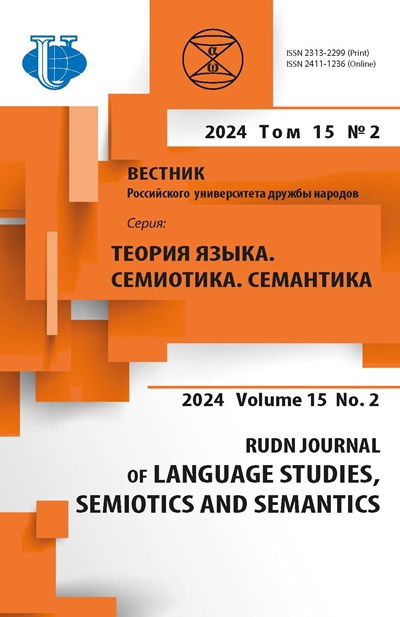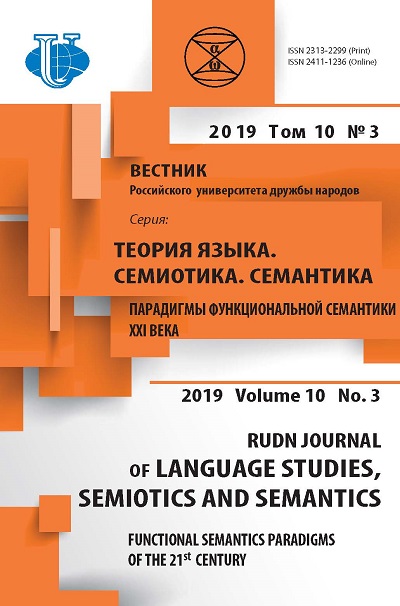Английский экономический термин «человеческий капитал» и его семантическое поле в научном дискурсе
- Авторы: Филясова Ю.А.1
-
Учреждения:
- Санкт-Петербургский университет технологий управления и экономики
- Выпуск: Том 10, № 3 (2019): Парадигмы функциональной семантики XXI века
- Страницы: 700-713
- Раздел: КОНЦЕПТОСФЕРА И ЭСТЕТИЧЕСКАЯ ФУНКЦИЯ ДРАМАТУРГИЧЕСКОГО ТЕКСТА И ДИСКУРСА
- URL: https://journals.rudn.ru/semiotics-semantics/article/view/22127
- DOI: https://doi.org/10.22363/2313-2299-2019-10-3-700-713
Цитировать
Полный текст
Аннотация
В настоящее время человеческий капитал (ЧК) приобретает особое значение в ответ на развитие цифровой экономики. Семантический анализ ЧК имеет теоретическую ценность для лингвистического описания экономического термина и практическую значимость для преподавания делового английского языка студентам экономических и управленческих направлений подготовки. Целями исследования были проанализировать словарные дефиниции, сопоставить их с контекстными определениями и выявить синтагматические отношения и лексическую сочетаемость термина ЧК в научном дискурсе. Материалом послужили 340 названий научных статей и их аннотаций из 18 журналов по экономике и менеджменту. Методы исследования включали сплошную выборку, анализ контекстных отношений, семантическую классификацию и компонентный анализ. В результате анализа дефиниций было выявлено, что ЧК имеет абстрактные компоненты значения и частично совпадает с термином ресурсы , но не с термином капитал , имеющим монетарную природу. Контекстные определения раскрывают больше аспектов значения термина ЧК. Монетарные отношения и факторы производства сближают его с капиталом . Большое внимание в научном дискурсе уделяется формированию и измерению ЧК. Экономические термины, контекстуально связанные с ЧК, охватывают широкое разнообразие явлений почти из всех функциональных областей бизнеса. Они указывают на важность ЧК для устойчивого развития, увеличения прибыли и конкурентоспособности. Семантическая классификация словосочетаний показывает, что ЧК рассматривается на личностном, организационном и национальном уровнях. Наиболее частотные синтагматические последовательности включают HC+N, N+Prep.+HC и Adj.+HC . Объектная валентная связь термина ЧК: V+HC - более распространенная, чем субъектная: HC+V . Наиболее употребительными словосочетаниями оказались HC accumulation , HC investments и the role of HC .
Об авторах
Юлия Анатольевна Филясова
Санкт-Петербургский университет технологий управления и экономики
Автор, ответственный за переписку.
Email: phill.yield@gmail.com
кандидат филологических наук, доцент кафедры педагогики, психологии и переводоведения
Санкт-Петербург, РоссияСписок литературы
- Халлидей М.А.К., Мартин Дж.Р. Письменная наука: грамотность и сила дискурса. Питтсбург, 1993.
- Кобозева И.М. Лингвистическая семантика. М., 2000.
- Трир Ж. Исследование словарного состава немецкого языка в смысловом поле понимания: Дисс.. д.ф.н. Бонн, 1931.
- Щур Г.С. Теории поля в лингвистике. М., 2009.
- Адмони В.Г. Основы теории грамматики. М., 1964.
- Бондарко А.В. Основы функциональной грамматики. СПб., 2001.
- Абрамов В.П., Абрамова Г.А. Структурный и функциональный подходы к анализу семантического поля // Вестник Российского университета дружбы народов. Серия: Русский и иностранные языки и методика их преподавания. 2017. Т. 15. no 1. С. 9—25.
- Уфимцева А.А. Лексическое значение. М., 1986.
- Кобозева И.М. Лексика в грамматике — функции, категоризация, ограничения // Русский язык за рубежом. 2016. no 3. С. 51—55.
- Шведова Н.Ю. Русский язык. М., 2005.
- Кацнельсон С.Д. О грамматической категории // Вестник Ленинградского государственного университета. 1948. no 2. С. 114—134.
- Теньер Л. Основы структурного синтаксиса. М., 1988.
- Денисенко В.Н. Синтагматика и парадигматика семантического поля // Вестник Российского университета дружбы народов. Серия: Теория языка. Семиотика. Семантика. 2011. no 2. С. 18—24.
- Аверина А.В. Валентность модальных слов и частиц в немецком языке // Вестник Московского государственного областного университета. Серия: Лингвистика. 2019. no 2. С. 43—52.
- Филясова Ю.А. Effectiveness vs. efficiency: анализ валентности и сочетаемости в техническом контексте // Вестник Российского университета дружбы народов. Серия: Теория языка. Семиотика. Семантика. 2019. Т. 10. no 1. С. 187—196.
- Касимова Г.К. Сопоставительный анализ семантической структуры однокоренных дериватов // Вестник Российского университета дружбы народов. Серия Лингвистика. 2013. no 4. С. 93—101.
- Мухачёва И.В. Семантические валентности глагола расстегнуть и явление невыразимости валентностей // Rhema. Рема. 2019. no 1. С. 48—64.
- Паймакова Е.А. Некоторые семантические особенности английских прилагательных антонимов (на материале прилагательных heavy—light) // Вестник Российского университета дружбы народов. Серия Теория языка. Семиотика. Семантика, 2010. no 1. С. 21—27.
- Райс С., Ньюман Дж. Корпусное исследование английских глаголов, обозначающих мыслительную деятельность, и их влияние на глаголы физической активности с элементами эпистемизации // Вестник Российского университета дружбы народов. Серия: Лингвистика. 2018. Т. 22. no 3. С. 560—580.
- Труфанова И.В. Лексикографический портрет местоимения иной // Вестник Российского университета дружбы народов. Серия: Теория языка. Семиотика. Семантика. 2017. Т. 8. no 3. С. 509—518.
- Юдина Н.В. Терминология родственных отношений в русскоязычном дискурсе ХХI века // Научное мнение. 2014. no 8. С. 13—23.
- Келли Дж.Дж. Практика применения дискурса в изучении и обучении наукам // Пособие по исследованию научной практики. Т. II. Нью-Йорк, 2014. С. 321—336.
- Мак-Комас В.Ф. Научный дискурс (риторика науки) // Научно-популярный язык. Роттердам, 2014.
- Филясова Ю.А. Моделирование системы непрерывного и тематического контроля уровня развития иноязычной коммуникативной компетенции // Вестник Российского университета дружбы народов. Серия: Русский и иностранный языки и методика их преподавания. 2015. no 4. С. 210—223.
- Костин А.В. От информационного общества к цифровому // Человеческий капитал в формате цифровой экономики: междунар. науч. конф. 16 февр. 2018 г. М. С. 72—80.
- Economics Letters. URL: https://www.journals.elsevier.com/economics-letters (accessed: 7.04.2019).
- The Economics of Education Review. URL: https://www.journals.elsevier.com/economics-of-education-review (accessed: 10.04.2019).
- Economic Modelling. URL: https://www.journals.elsevier.com/economic-modelling (accessed: 12.04.2019).
- The Journal of Human Capital. URL: https://www.journals.uchicago.edu/toc/jhc (accessed: 15.04.2019).
- The Journal of Intellectual Capital. URL: https://www.emeraldinsight.com/loi/jic (accessed: 18.04.2019).
- Labour Economics. URL: https://www.journals.elsevier.com/labour-economics (accessed: 20.04.2019).
- Journal of Management. URL: https://journals.sagepub.com/home/jom (accessed: 24.04.2019).
- Review of Development Economics. URL: https://onlinelibrary.wiley.com/journal/14679361 (accessed: 25.04.2019).
- The Journal of Human Resources. URL: http://jhr.uwpress.org/ (accessed: 28.04.2019)
- The Journal of Comparative Economics. URL: https://www.journals.elsevier.com/journal-of-comparative-economics (accessed: 1.05.2019).
- The Journal of Monetary Economics. URL: https://www.journals.elsevier.com/journal-of-monetary-economics (accessed: 3.05.2019).
- Strategic Management Journal. URL: https://onlinelibrary.wiley.com/journal/10970266 (accessed: 5.05.2019).
- International Economic Review. URL: https://onlinelibrary.wiley.com/journal/14682354 (accessed: 7.05.2019).
- Journal of Economic Surveys. URL: https://onlinelibrary.wiley.com/journal/14676419 (accessed: 10.05.2019).
- The Human Resource Management Journal. URL: https://onlinelibrary.wiley.com/journal/ 17488583 (accessed: 12.05.2019).
- Global Business Review. URL: https://journals.sagepub.com/home/gbr (accessed: 14.05.2019).
- The Human Resource Management Review. URL: https://www.journals.elsevier.com/human-resource-management-review (accessed: 15.05.2019).
- The Journal of Finance. URL: https://onlinelibrary.wiley.com/journal/15406261 (accessed: 16.05.2019).
- Cambridge Dictionary. URL: https://dictionary.cambridge.org/ (accessed: 18.05.2019).
- ENCYCLOPÆDIA BRITANNICA. URL: https://www.britannica.com/ (accessed: 19.05.2019).
- Macmillan Dictionary. URL: https://www.macmillandictionary.com/ (accessed: 21.05.2019).
- The Business Dictionary. URL: http://www.businessdictionary.com/ (accessed: 24.05.2019).













